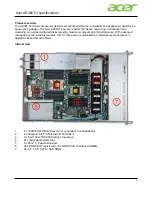
Removing and Replacing Disks
5-14
Express5800/
ftServer
: System Administrator’s Guide for the Linux Operating System
N O T E
The device names displayed in
/proc/mdstat
are the
kernel names for each device. These are different from
the user device names displayed by the
mdadm
command.
Example 5-2. Checking the Current State of RAID
#
cat /proc/mdstat
Personalities : [raid0] [raid1]
md30 : active raid0 md21[1] md20[0]
286743808 blocks 64k chunks
md21 : active raid1 sdf1[1] sde1[0]
143371968 blocks [2/1] [_U]
md20 : active raid1 sdd1[1] sdb1[0]
143371968 blocks [2/2] [UU]
md1 : active raid1 sdc2[1] sda2[0]
2096384 blocks [2/2] [UU]
md2 : active raid1 sdc3[2](F) sda3[0]
31647936 blocks [2/1] [U_]
md0 : active raid1 sdc1[1] sda1[0]
2096384 blocks [2/2] [UU]
unused devices: <none>
In this example, md30 is a RAID-0 array made up of md20 and md21. The remaining
stanzas are for RAID-1 arrays. Note that md21 is operating in degraded mode. It is
missing a disk:
[2/1]
[_U]
.
Removing and Replacing Disks
For disk fault tolerance, disk mirrors must be maintained when disks or CPU-I/O
enclosures are removed and replaced. For information about the recommended
partnering confirmation for internal disks, see ‘‘
Configuring Internal Disks’’ on page 5-3
.
This section discusses the following topics:
•
‘‘
Disk Insertion
”
•
‘‘
Administering RAID Arrays
”
















































